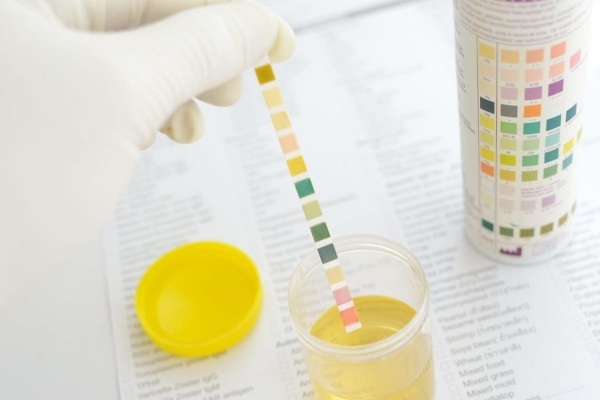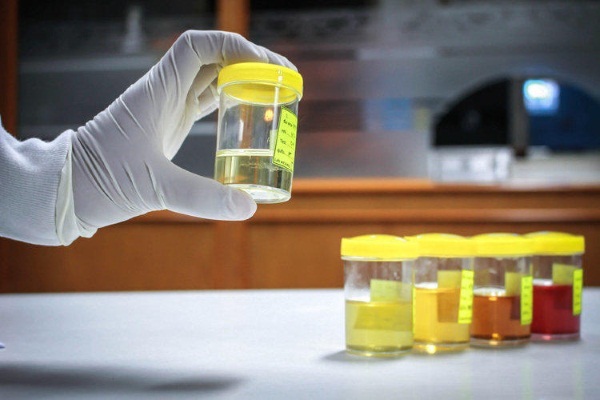Analysis of urine - a fast and informative method for diagnosing inflammation. It allows you to determine the content of proteins, sugar, enzymes. Leukocyte esterase is an important marker of the body's protective status. It is found even after the death of white blood cells.
Record content:
- 1 What is Leukocyte Esterase?
- 2 Purpose of the analysis
- 3 How is the decoding of urine research carried out?
-
4 Decoding and norm of content in urine
- 4.1 In men and women
- 4.2 Indicators during pregnancy
- 4.3 Content in urine in children
- 5 Diagnostic methods
- 6 How to properly prepare for the study?
- 7 Features of the study of children
- 8 Leukocyte esterase during pregnancy
- 9 Reasons for an increase in leukocyte esterase
- 10 False results and their causes
- 11 What to do with positive leukocyte esterase results?
- 12 Video about leukocytes in urine
What is Leukocyte Esterase?
This biochemical compound is a hydrolytic enzyme in white blood cells. It is released into uric acid after the destruction of leukocytes, which in the process of phagocytosis (intracellular cleavage) are destroyed, suppressing the vital activity of pathogenic agents and foreign microorganisms.
White blood cells play an important role in the immune mechanism, capturing and destroying the pathogens of various diseases and inflammations secreted by enzymes. However, in this case, the destruction of the biological structure of leukocytes inevitably occurs.
As a result, esterase appears in the urine and is excreted along with it from the body. The amount of this hydrolytic enzyme in urine indicates not only the presence of an inflammatory process, but also the nature of its course.
Purpose of the analysis
Leukocytes have the ability to penetrate into the tissues of organs from the bloodstream to suppress the activity of microbial pathogens. The detection of a hydrolytic enzyme in uric acid increases the information content of laboratory diagnostics, since it is detected regardless of the content of white blood cells in it.
Often such an analysis is prescribed as a screening test in order to monitor the effectiveness of therapy:
- pyelonephritis;
- glamerulonephritis;

- urethritis;
- prostatitis;
- cystitis;
- amyloidosis.
A laboratory study of a biomaterial allows you to identify pathological processes in the urinary system at an early stage, which greatly facilitates treatment. An increased concentration of leukocyte esterase may indicate inflammation in the kidneys.
To clarify the diagnosis, an additional examination is prescribed. Traces of adipocyte cells, which form the basis of adipose tissue, indicate a violation of metabolic processes, dystrophic changes in the organs of the abdominal cavity and small pelvis, their infectious infections.
Leukocyte esterase in urine is present in increased concentration in some pathologies of the reproductive apparatus in women and in liver diseases. An important goal of such an analysis is to identify the inflammatory process at the initial stage of its formation and development.
An elevated level of this enzyme clearly indicates attempts by blood corpuscles to neutralize pathogenic pathogens that have penetrated the kidneys, bladder, and urethral cavity.
In most cases, in parallel with leukocyte esterase, signs of bacteriuria are found - the presence pathogenic microorganisms in uric acid, where they get from the abdominal organs, genital system, small pelvis.
How is the decoding of urine research carried out?
The content of the hydrolytic enzyme of white blood cells is usually determined in a biological fluid in the course of a general or biochemical laboratory study, along with other characteristics.
Leukocyte esterase in urine and the level of its concentration are evaluated in combination with such important indicators as:
- protein components;
- glucose;
- the composition of the microbial flora;
- bile pigments;
- ketone components;
- hemoglobin;
- elements of inorganic origin;
- epithelial cells and their derivatives.
A comprehensive study allows you to establish an overall clinical picture and minimize the likelihood of a false-positive result. The increased content of this hydrolytic enzyme and the accompanying pathogenic microflora give the urine a dull color.
Sometimes the phenomenon of sterile leukocyturia occurs, in which esterase is found in the urine, but pathogens are absent. In this case, clarification of the results, additional examination, and repetition of the laboratory test are required.
For the correct interpretation of the analysis results, accurate anamnestic information and data on the intake of medications that can affect the chemical formula of urine are required.
To establish the composition of the accompanying microbial flora, bacteriological inoculation and a nitrate test are performed. The biomaterial is examined by microscopy or using special laboratory markers impregnated with a chemical compound that reacts with leukocyte esterase.
Decoding and norm of content in urine
The level of the hydrolytic enzyme of white blood cells should not exceed 5 units in the field of view in men and 3 in women. A higher concentration may indicate the development of an inflammatory process in the genitourinary system, urethral cavity or renal organ.
Semi-quantitative determination of the content of the phagocytic enzyme is carried out as standard. It is marked with a "+" sign in the analysis results. If the level is below the minimum detection threshold, the chemical will react negative to leukocyte esterase. An increased concentration of neutrophil cells is a clear indication of an inflammatory process.
The rate and content of leukocyte esterase in uric acid:
| Analysis result | Estimated concentration |
| negative | Below the detection threshold |
| Phagocytic enzyme traces | 25 leukocytes / μl |
| + | 75 / μl |
| ++ | 250 / μl |
| +++ | 500 / μl |

75 leukocytes per microliter of uric acid may indicate the initial stage of inflammatory process or be associated with some side factors that affect the reliability of the result analysis. A clarification of the diagnosis is required here.
Leukocyte esterase, which is contained in urine in a quantity of 250 / μl, most often indicates a bacterial infection of the renal organ, urethral cavity or prostate in men. A consultation with a urologist is required.
If leukocytes are detected in a laboratory urine test at a concentration of 500 and above, an acute stage of the inflammatory process is suspected. It is usually accompanied by painful symptoms and urological dysfunctions.
In men and women
Both sexes have both common clinical and biochemical signs of deviation from the norm in the content of the phagocytic enzyme in uric acid, and gender differences.
In men, an increase in the level of leukocyte esterase can be caused by:
- inflammation of the prostate gland;
- balanoposthitis - a bacterial lesion of the head of the genital organ and a leaf of the foreskin;
- adenocarcinoma of the prostate - malignant tumor destruction;
- phimosis - congenital or acquired narrowing of the lumen of the skin of the penis.
Urinalysis to determine the level of a hydrolytic enzyme in white blood cells is not used to make a definitive diagnosis. It serves only as a basis for additional examination.
In women, the deviation from the norm in the content of leukocyte esterase is due to a large group of factors, both pathological and natural physiological.
The first are:
- inflammation of the bladder and its mucous membrane;
- pyelonephritis - damage to the kidney tissue;

- vulvovaginitis - a disease localized in the vaginal cavity;
- candidiasis;
- oncological neoplasms.
Excessive physical exertion of a static type, fever, and antibiotic therapy with cephalosporins are considered common for both sexes to increase the content of leukocyte esterase in urine.
The level of phagocytic enzyme can change when taking non-steroidal anti-inflammatory drugs or using radio-opaque substances.
Indicators during pregnancy
In such a specific physiological state of the female body, the value of leukocyte esterase 6 units / μl of uric acid is considered normal. Exceeding the established indicator requires additional examination.
Hormonal changes and preparation of the body for childbirth lead to a slight increase in the release of a hydrolytic enzyme into uric acid. During conception, a significant accumulation of leukocytes is observed in the uterine organ. In this way, the body protects the embryo from pathogenic pathogens.
Leukocyte esterase in urine during pregnancy is always found in increased concentration. Closer to childbirth, this value decreases. Otherwise, the woman is prescribed an additional examination.
The clinical picture is considered pathological and requires treatment if, due to fetal pressure on the walls of the bladder, it develops inflammation, muscle tone decreases and stagnation occurs in the organ, which create a favorable environment for the penetration of pathogenic pathogens.
The migration of leukocytes into the uterus is a natural defense mechanism of the female body during pregnancy. A large accumulation of these blood cells leads to an intensification of the production of a phagocytic enzyme, which is excreted through the urinary ducts.
Content in urine in children
Slightly in an infant, the content of the hydrolytic enzyme of leukocytes may increase during teething. The norm is a value of up to 8 units when examining a biological fluid by microscopy.
The consequences of childhood infectious diseases lead to a slight increase in leukocyte esterase even with a completely suppressed vital activity of pathogenic agents. In infants, inflammatory processes are often asymptomatic, causing only an excess of the established norm by the phagocytic enzyme.
Diagnostic methods
An increased concentration of leukocyte esterase in biological material may be a sign of one or more pathologies of internal organs, reproductive or urinary system.
Therefore, additional diagnostics are often required to clarify the diagnosis, determine the area of localization and the anatomical and physiological characteristics of the inflammatory process. In the course of such an examination, the genotype of the infectious pathogen or other reasons for the development of the pathology is determined.
In addition to urine analysis, carry out:
- generalized and biochemical blood test;
- bacteriological culture;
- Ultrasound of the kidneys;
- computed tomography of internal organs.
The doctor may order urography. It is performed by the urethroscopic method. A 3-glass sample is often used. This method of laboratory diagnostics involves dividing the total volume of the obtained biological material into the initial, middle and final phases.
Leukocyte esterase in urine increases unevenly. By the principle of its distribution in different parts of the urine, it is possible to find out the reason for the increase in the volume of the hydrolytic enzyme of white blood cells.
The diagnostic method of Nichiporenko provides for the determination of the ratio of erythrocytes and leukocytes in 1 ml of uric acid. There is a 2-glass sample method in which the middle phase is excluded, only the initial and final are taken into account.
With the Kakovsky-Addis method, biological material collected during the day is examined. Laboratory diagnostics by the method of qualitative analysis of leukocyturia provides for supravital staining to determine the variety of these blood cells.
For each patient, the method of determining the level of the phagocytic enzyme is individually selected. In some cases, the doctor may order a biopsy and a smear to analyze the composition of the microflora of the genital area.
A high efficiency is shown by a prednisolone test, which is able to reveal latent leukocyturia. It is based on the biochemical aggressiveness of a synthetic glucocorticosteroid, which causes a short-term exacerbation of the inflammatory process.
The Addis-Kakovsky method of isolating shaped components and sedimentary cylinders is rarely used, since cells are rapidly destroyed during the daily collection of biological material. More often, a similar 12-hour method is used, in which the leukocyte esterase detected during this period is recalculated for 24 hours.
The method of laboratory research according to Amburge allows you to establish what is excreted in the urine in 1 min. the volume of the phagocytic enzyme. Many pathological processes in the renal organ at the initial stage of formation have a blurred clinical picture.
To clarify it, the Amburge diagnostic method is intended. Regardless of the applied research method, the level of leukocyte esterase should not exceed 5 units. Exceptions are children, pregnancy and the menstrual cycle. In the latter case, it is better to postpone the delivery of the analysis.
How to properly prepare for the study?
You should not collect biological material in a household container that is poorly suited for this. Such containers can distort the analysis result. The reliability of the study of urinary suspension is the key to the correct diagnosis and the correct choice of therapeutic tactics.
Household containers contain microorganisms that can significantly affect the result of the study of biological material.
It is necessary to adhere to other important rules for preparing for the test:
- Use only a sterile medical container for the intended purpose purchased from a pharmacy.
- Before the procedure for collecting urine, you need to thoroughly wash your hands and external genitals in order to exclude the influence on the result of the analysis of the microbial factor.
- For hygienic processing, it is advisable to use a large amount of warm water and toilet soap with antibacterial properties.
- The initial phase of urinary fluid must be drained into the toilet, and the middle phase must be carefully collected into a container.
For research, 50 ml of biological material is enough. The last portion of urine must also be drained down the toilet. The container is tightly closed with a complete lid, put into a plastic bag and taken to the laboratory.

It is best to collect biological material in the morning before meals. An important nuance lies in the rapid decomposition of phagocytic cells outside the body. Therefore, it is recommended to collect urine just before visiting the laboratory.
Features of the study of children
An increase in the level of leukocyte esterase in a child indicates the likelihood of developing the same inflammatory processes as in adults. It can be cystitis, urethritis or pyelonephritis. Failure to observe personal hygiene and taking certain medications can distort the analysis result.
In children, there is a direct link between allergic manifestations and an increase in the content of the hydrolytic enzyme of leukocytes in the urine. This is due to the immune competence of the white blood cells.
Such a result is considered to be false positive, that is, not associated with the presence of an inflammatory process in the child's body. An increase in the level of the enzyme in the urine is observed after suffering from acute respiratory infections.
With a normal content of leukocytes in the blood, an excessive release of esterase into urine is not a cause for concern. Therefore, the result of the study of urinary fluid in a child is assessed only in conjunction with a general blood test.
Physiological, immune and hormonal instability of the child's body often leads to dysfunctions of the urinary system. Some of them are virtually asymptomatic before flowing into an acute form.
Urine analysis for the content of phagocytic enzyme is the only way to diagnose inflammatory the process at an early stage, when its suppression is a relatively simple set of therapeutic procedures.
Leukocyte esterase during pregnancy
In such a physiological state of the female body, white blood cells are produced more intensively than usual.. This leads to an increase in the level of their hydrolytic enzyme in uric acid.
If other diagnostic methods have not revealed microbial contamination, and there are no symptoms of the inflammatory process, there is no reason for concern. During pregnancy, stagnation of urinary fluid is often observed, which contributes to the development of bacteriuria and pyuria.
In some cases, an increased content of white blood cells and their phagocytic enzyme indicates the development of candidiasis. It was recommended to conduct additional research and make bacteriological inoculation.
In case of detection of an inflammatory process, pregnant women are prescribed a special therapeutic regimen using drugs that have an established safety profile for the embryo.
In such a physiological state, a slight increase in leukocyte esterase is normal, due to the protective functions of white blood cells, as well as compression of the bladder against a background of low muscle tone.
If the indicator is greatly overestimated, it is worth paying attention to the content of protein components and erythrocytes in uric acid. A comprehensive assessment will make it possible to diagnose inflammation of the renal tissues in time, in which such a clinical picture is observed. 6-8 units / μl of uric acid is normal during pregnancy.
Reasons for an increase in leukocyte esterase
The level of hydrolytic enzyme in urine is affected by pathological disorders of various origins and localization. The leading role in a positive test result for leukocyte esterase belongs to cystitis.
This disease, due to anatomical features, is more typical of women than men. The cause of inflammation is the penetration of pathogenic pathogens into the bladder cavity.
Men are more likely to be affected by urethritis, which is also associated with an increase in the hydrolytic enzyme of leukocytes in the urinary fluid.
Other common reasons include:
- urolithiasis;
- pyelonephritis - a complicated form of cystitis;
- interstitial nephritis - acute inflammation of the renal tubules;
- infectious prostatitis;
- tuberculosis;
- urogenital infections;
Some increase in the level of leukocyte esterase is observed in chronic renal failure.
False results and their causes
Physiological, hygienic and medicinal factors that are not associated with the development of the inflammatory process can increase the content of the hydrolytic enzyme of leukocytes in the urine.
The penetration of vaginal secretions into the biological material and the course of treatment with antibacterial drugs based on modified clavulanic acid distort the results of the analysis.
An increased concentration of glucose and protein compounds is also capable of artificially increasing the level of leukocyte esterase. False positive results are observed when urobilinogen (a bile enzyme) is released into the urine and when cephalosporin antibiotics are taken.
What to do with positive leukocyte esterase results?
To clarify the diagnosis, a re-delivery of the analysis and an additional examination are prescribed. Bacteriological inoculation is carried out. It helps to select an antibiotic to which the detected genotypes are highly sensitive.
An increase in leukocyte esterase is not an independent disease, but just a diagnostic sign that requires clarification. In the inflammatory process, in most cases, along with phagocytic cells, pathogenic microflora is fixed in the urine.
Video about leukocytes in urine
The reasons for the increase in leukocytes in the urine:



